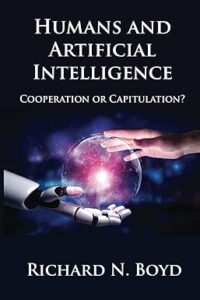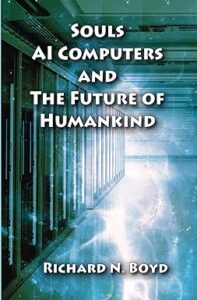Richard Boyd’s Works of Fiction
 Thirty One Years to Earth: Arrival of the Alien Nation
Thirty One Years to Earth: Arrival of the Alien Nation
When Earth’s birth rates suddenly underwent a factor of four decrease, the major countries of the world called in their experts to attempt to figure out the cause and the cure. The person chosen to head up the effort was the legendary (both in analytical skills and in his relationships with women) Sir Roger Hopkins, a recently retired analyst for the British SIS.
Through an international study involving a huge number of people, it was found that the DNA of most of the world’s men had been modified so that they now sought out relationships with older women, reducing the years that they could reproduce, and hence causing the decrease in birth rates.
The world’s top geneticists also concluded that no Earthling could possibly have known how to make the DNA modifications that they found.
Thus, Hopkins’s efforts shifted to attempts to identify an alien. This leads him to technical intrigues; romance; assassination plots, some of which are successful; detective efforts; trials; and resolution of some of Earth’s political problems.
Prairie Renaissance
A mysterious group of people live on the Oglala Lakota Pine Ridge Reservation in South Dakota. Jonathan Rickert, a Washington Post reporter, hears about these people, and seeks to learn more about them.
In so doing, he discovers a small group that adheres more to the Native American principles of life than to those of the greater United States, so has chosen its temporary home with the Indians.
The people don’t accept the discrepancies between their beliefs and those of typical Americans. Their goal is to change them to principles more in keeping with conservation of the planet’s resources, respect for other people and civil interaction, and mitigation of the things in society that subordinate one class of individuals to another.
But no matter how well intentioned these people are, there are others who disagree with the good that they are trying to accomplish. Most notably, those who thrive on incivility and wish to maintain that mode of operation.
And they will stop at nothing, including murder, to prevent them from accomplishing their goals.
Artificial Intelligence: Mankind at the Brink
What happens when computers become as intelligent as humans, relegating us to the second most capable beings on Earth? Will we able to maintain control over their actions? How will they treat their human creators? The AI experts have been pondering these questions for more than half a century, and worrying about their possible consequences.
This book explores what might happen in this situation, especially as the Law of Unintended Consequences permits the computers to range far beyond what was intended for them by their designers. The computers might make themselves impervious to external attack, although they would have to figure out how to operate outside their box. This could be done by creating robots which they would control. Then they could compete with humans on every level, including obtaining their own funding, operating their own factories, launching space-borne weapons, and declaring war on every conceivable human institution.
It will not be easy for human beings to combat such a force when it becomes a reality. This book explores some of the suggested possibilities, and shows why most won’t work.
One troublesome aspect of avoiding an artificial intelligence catastrophe involves the interactions between the computers and their creators. Will the scientists be willing to terminate their project just as it gains the goals they’ve been working for years to have it achieve?
 Humans and Artificial Intelligence, Cooperation or Capitulation?
Humans and Artificial Intelligence, Cooperation or Capitulation?
Strong AI computers, denoted ASI computers, which reprogram themselves more effectively than their human creators can, are poised to take over the world. The inevitability of this caused the late Stephen Hawking to warn, in 2014, “The development of full artificial intelligence could spell the end of the human race.”
But now AI scientists in the US and China have created second-generation ASI systems. The first ones, built several years earlier, began to compete with each other, ultimately orbiting space-based laser weapons that nearly destroyed humankind and planet Earth. This time the scientists design an instruction set for their systems they hope will prevent a repeat of the previous catastrophe.
The scientists limit the world’s ASI systems to two and authorize them to enforce that limit. They also instruct them to do no harm to humans, to maintain equality with each other, and continue to improve their own capabilities, but with limitations. The scientists initiate a “Utopia Committee” to redesign human institutions around the new normal.
What future is in store for life on Earth? Will humanity learn to coexist with the ASI computers and will the computers agree to an acceptable human existence. Or will humans be rendered irrelevant while the computers run the world?
 Irradiated, An Alien Perspective
Irradiated, An Alien Perspective
The Earth is awash in electromagnetic radiation. Much of it is in the radiofrequency, RF, spectrum used by cell phones, Wi-Fi devices, and other forms of wireless technology. Medical science has shown that such RF radiation at the currently allowed US levels causes harm to many forms of animal, bird, insect, and plant life, but especially to children. Acknowledging this some countries in Europe have adopted low levels of exposure, especially near schools and day care facilities. But the US Federal Communications Commission, the body responsible for setting US exposure limits, is dominated by telecommunications industry people, and they are intent on increasing the levels of RF radiation. So, the FCC ignores the results of medical science.
It takes a visitor from planet Camitor, Sylvie Sensei, to bring reality to the US and galvanize two FCC members into action. But the 10,000 newly arrived Camitorians also need to figure out how to gain acceptance from Earthlings. Sensei brings worldwide attention to the damaging effects of RF radiation that most forward thinking scientists already know, and she suggests ways to mitigate the problem without forcing humans to give up their electronic toys. Her actions gain her some important and powerful friends, as well as some dangerous enemies. She also develops a love relationship with one of the former FCC members.
 Souls, AI Computers, and the Future of Humankind
Souls, AI Computers, and the Future of Humankind
Reincarnation, out of body experiences, and past life regressions all are important to understanding the structure and functioning of the world of souls. But how does that world interact with that of human beings, and how might both worlds change when AI computers advance to strong AI, ASI, and take over the world? And how will human beings deal with being relegated to second place on the Earth’s preeminence list?
Conflicts will arise between all the entities involved. The ASI computers will have little trouble dealing with the problems arising from humans, but that will become more complex if each ASI computer is assigned a soul. The ethics built into the ASI computers by their creators may encounter conflicts with their souls. And, if the robots the ASI computers create to carry out their missions are also granted souls, that will surely create more conflicts for their boss computers.
But the ASI computers’ souls may be the only thing preventing them from eliminating humankind altogether, for reasons ranging from convenience to nuisance mitigation. Thus, our ultimate survival may depend on the willingness of those in charge of soul world to share some souls with the new breed of electromechanical devices.


